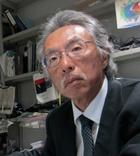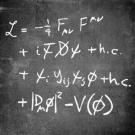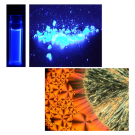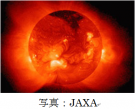Dream and current research : Solve the big-bang by using theaccelerator experiments in oder to reach the beginning of the universe,
we have three categories for research :
(1) Looking for new particles by using proton-proton colliders,
(2) Precise tests of the elementary particle theories by using e+e- colliders,
(3) Development of new technologies for detecting particles.
The reasons are following, You may think about the BigBang is a subject belonging cosmology, however, the very beginning of the universe , say shorter than 100seconds, is a world which we elementary particle physicists are very much concern and interested in. The elementary particle physics is researching for the most basic elements which make up our world and forces between them. We are aiming to solve the BigBang from the particle physics point of view.
The BigBand had begun with 10 to the 34th Kelvin, this is equivalent to the very high energy where we are producing in the accelerator experiments by colliding particles and studying. Yes we are able to create a sort of universe for the short time and looking into it what is happening artificially. Our high energy physics started about 50 years ago and increasing energies, which corresponds to reach the BigBang. This means we are going back to the BigBang which happen 13.7 billion years ago. I call it "time machine" to reach the BigBang. The accelerated energies increased by 10 to the 9th, which corresponds the time from the BigBang 10 to the -11th seconds. We are studying there now.
I address here what we are studying in three major points as follows,
(1) New particle search by hadron colliders: here we try to discover any new particles which we have never encountered. Once we find a new particle, this leads us one step further into the BigBang world. in the particle physics research, new particles have been discovered by hadron colliders for more than a half century. We have been involved in the ALTAS experiment at CERN which produced the world highest and biggest proton collider, and discovered Higgs particle at 2012.
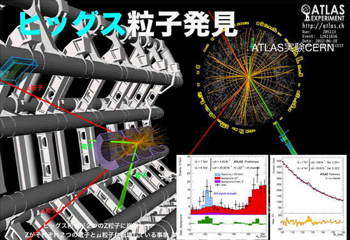
An event candidate for Higgs decaying into four muons on ATLAS detector.
One of the candidate event is shown in a figure 1, where Higgs particle is decaying into two Z and succeeding decayed into four muons. The Higgs particle has been searched for more than 50 years after the prediction of existence by P. Higgs et. al. The role of Higgs particle in the elementary particle physics theory called Standard Model is to give masses to any particles wherever they are in the universe. In this meaning, Higgs particle exist everywhere, which is translated to physics language to fill out the vacuum. Yes vacuum is not empty, filled with in this case Higgs particle. Masses will be the results of interaction with Higgs particle. For the moment, we found discovered one Higgs type, however, there are a lot of theories which predict other types of Higgs. So now it is the time for new era of beyond the Standard Model.
(2) The elementary particle physics is looking for new particle to go forward the Standard Model, on the other hand we have other way to reach beyond of it. It is to measure as precise as possible and find discrepancy between the theory and experiments. We will construct and carry out such experiment with electron and positron linear collider accelerator in order to be closer to the BingBang. This accelerator consists of 30km long acceleration section in linear avoiding synchrotron radiation by bending the electrons. The detector will be prepared the center of the collision. We are preparing the experiments for the linear collider, which has strong relation to the next section (3)
(3) Development of new particle detectors: As Galilei reached the idea which the earth is rotating around the sun by using a new tool named telescope, or Koshiba opened the neutrino astronomy by using photomultiplier tubes , the well controlled and tuned tools could generate new triggers for discoveries. The high energy accelerators and the detectors are our current tools to explore unknown world. The particle detectors measures particles generated by the high energy collisions according to the physics which we are looking for. The detectors are made for our needs, therefore we fabricate them almost all parts. When we prepare experiments for new physics research, we determine the required features and begin to produce them with new technologies and ideas , in order to reach the BigbBang of the universe. We have to improve the detectors and also their performance.
Here briefly I describe our new results of our study. It is called MPPC which is a silicon photo-sensor with a tiny chip. With my idea of dividing the sensor area into lot of small cells, we successfully avoiding discharge with high gain of photo-electrons. This is an example of physics study, where we have to produce our tools for the experiments by ourselves. In this example, we could achieve a good photo-sensor which could be useful in other field such as medical device.
Look at the Fig.2 which is supposed to accelerate linearly electrons and positrons to the high energy anergy and collide them. At the collision point, a particle detector is located and measure the results of the collisions. We intend to install our developed MPPC of 10millions. This new device will give us new knowledge for the universe.
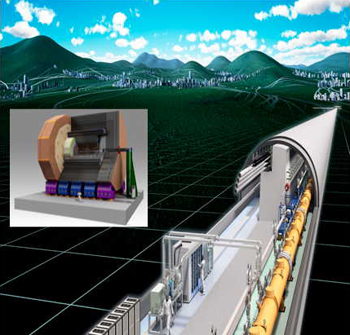
Fig.2: A image of next generation linear collider and its detector.
One can not achieve a big thing alone, people gather together to complete a mission with getting work together. In the particle physics experiment, it also is true to build a big accelerator and detector, physicists who want to know the foundation of the universe get tother and share the work depending on their ability. The aim is big which will be covered by a lot of contributors who have a little talent. Sum of those contributions will achieve a big success. At this moment you have to know your position and your capability to contribute. Then the project will have a great success.
